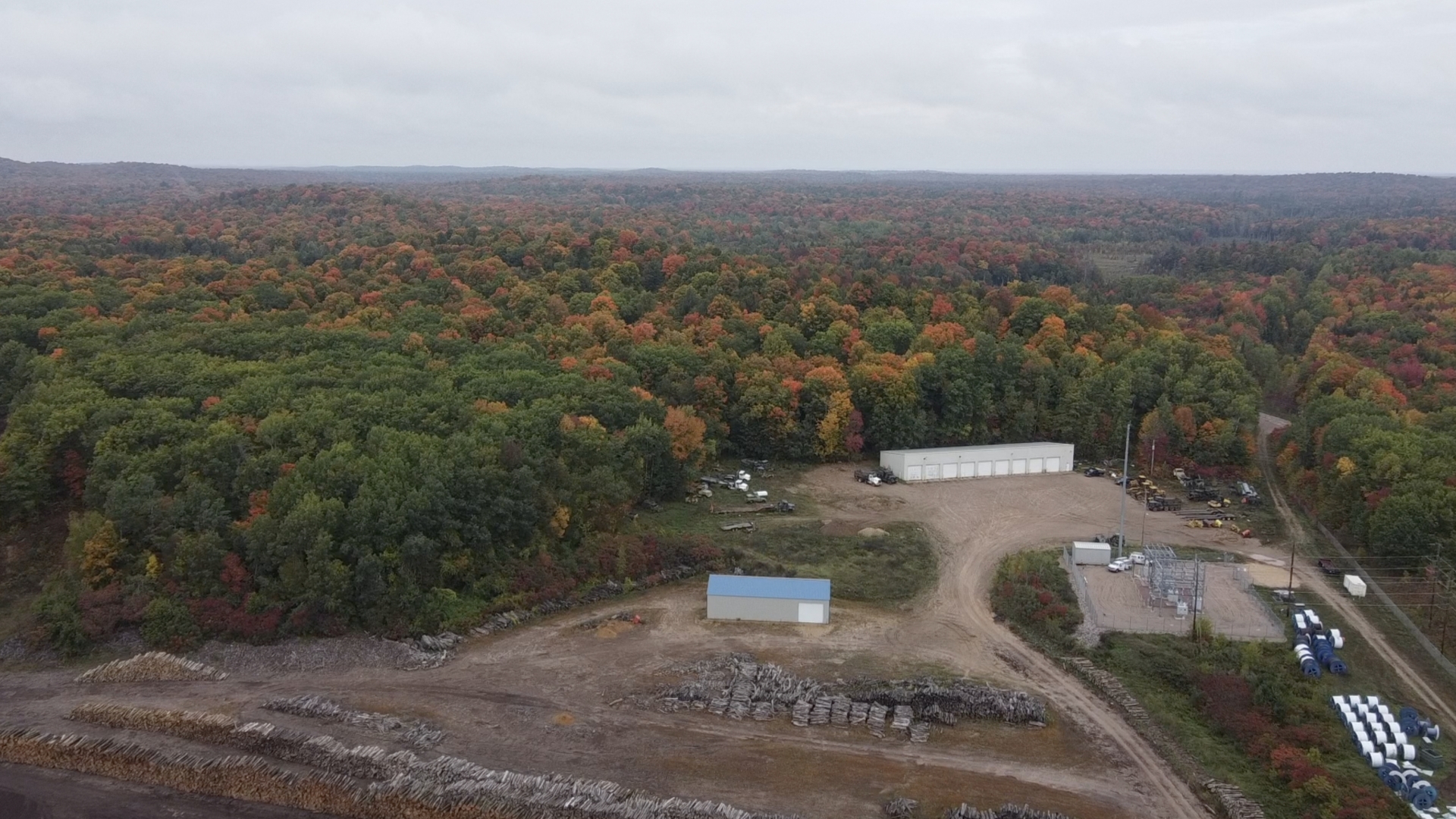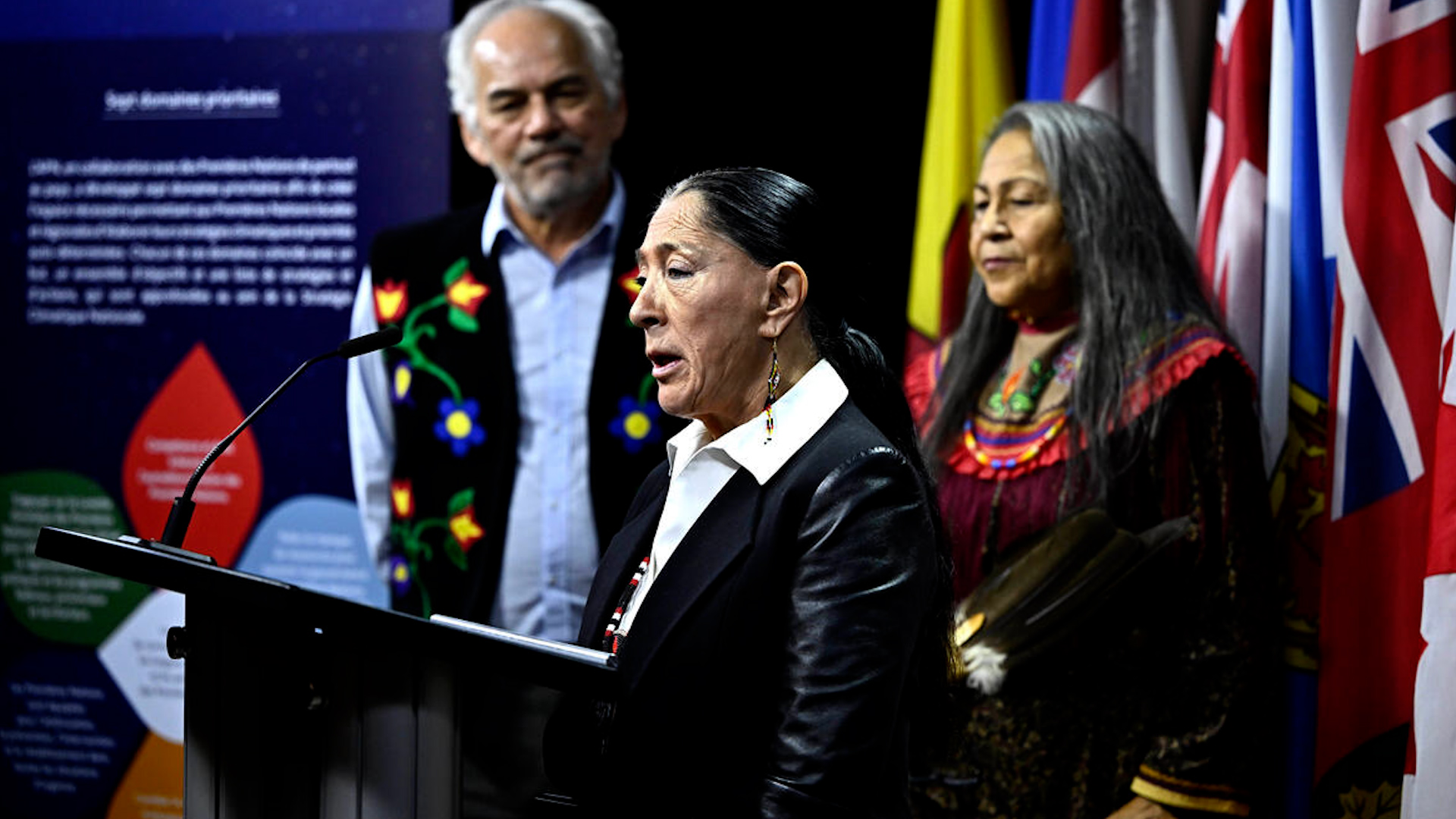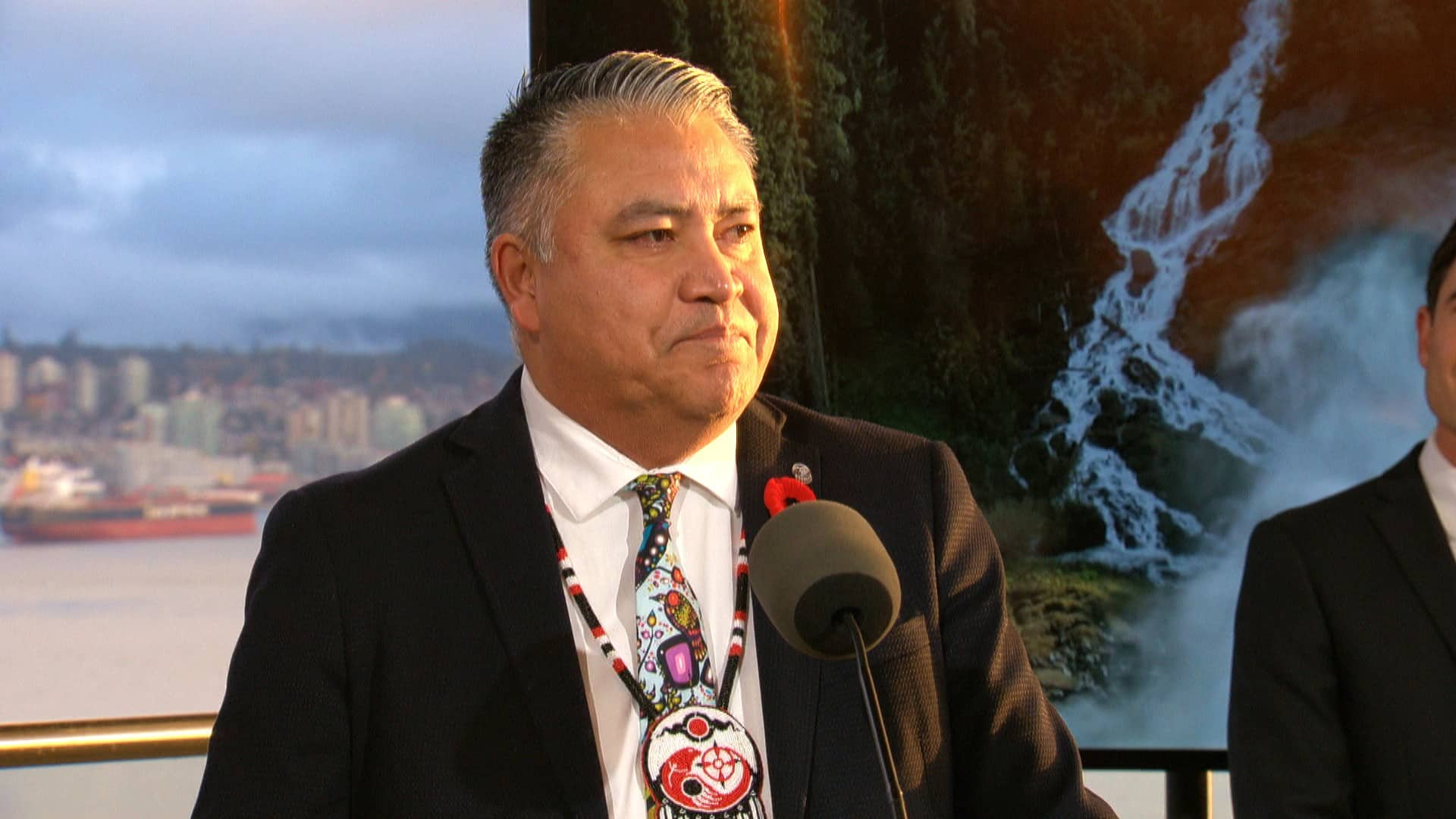
OTTAWA — Indigenous leaders from British Columbia have called on the federal government to stand by plans to transition away from open-net salmon farms, but an industry spokesman suggested the leaders were wading into political waters.
The chiefs were in Ottawa to stress the importance of the federal government's commitment to removing open-net salmon farms from B.C. waters by 2025, Bob Chamberlin, First Nations Wild Salmon Alliance chair, said Tuesday. The group represents more than 120 First Nations.
The chiefs met with Fisheries Minister Diane Lebouthillier and other federal officials, telling them most B.C. First Nations want open-net farming ended to help threatened wild salmon stocks, he said.
Open-net fish farms off B.C.'s coast are a long-running subject of debate, with opponents saying they are linked to the transfer of disease to wild salmon, while supporters say thousands of jobs are threatened if the operations are phased out.
"The chiefs who have made the trip to Ottawa are here to ensure that the meetings that we have, that the government clearly understands the breadth of support to remove fish farms from migration routes of wild salmon," Chamberlin said at a news conference.
But Brian Kingzett, executive director of the B.C. Salmon Farmers Association, said the alliance's news conference was more about bringing an anti-salmon farming message to Ottawa.
Related video: B.C. hatchery describes effects of urbanization on salmon (cbc.ca) Duration 2:03 View on Watch
"Aquaculture in B.C. is a polarized subject and they're saying the same old words," he said. "They're trying to use politics to distract from what's actually a fairly responsible process that's going on."
Chamberlin acknowledged support for the transition plan isn't unanimous among Indigenous people in the province, where about a dozen First Nations are involved in the salmon farming industry.
Kingzett said some First Nations have transformed their economies through salmon farming operations on their territories.
Last month, the B.C.-based Wild Salmon Forever conservation group sent a letter to Prime Minister Justin Trudeau supporting the alliance and calling for the federal government to stick to its 2025 transition commitment.
"In British Columbia over 123 First Nations representing Indigenous Peoples across the province are calling for the removal of open net-pen salmon farming due to its impact on their cultural, economic and spiritual way of life," said the letter.
"Canada stands alone on the Pacific coast in allowing the open net-pen industry to discharge pollutants, pathogens and parasites along migration routes of endangered Pacific salmon for free."
In February, former fisheries minister Joyce Murray said the government would not renew licences for 15 open-net Atlantic salmon farms around B.C.'s Discovery Islands near Campbell River on Vancouver Island.
Murray announced last June the extension of a consultation period to allow more input from all sides in the salmon farming debate ahead of the government's announcement of a transition plan.
Lebouthillier, who was appointed fisheries minister in July, has yet to announce the release of the government's transition plan.
Kingzett said the minister has been meeting with more people and groups than just the First Nations Wild Salmon Alliance.
"She's meeting with all the producer companies," he said. "She's meeting with suppliers. She's meeting with activists and she's meeting with First Nations who are engaged with the industry and she's meeting with groups like Wild Salmon Alliance who oppose the industry," he said. "She's doing her job and making sure she's doing a proper consultation."
Chamberlin said Trudeau should remind Lebouthillier her mandate includes developing a plan to transition from open net-pen salmon farms in B.C.
"I urge the prime minister to look in on the new minister Lebouthillier and ensure she has the support of the prime minister and his office, of cabinet, to do what's right for First Nations in B.C., the ones who have stood up and said to the government 'we support this.'"
Lebouthillier was not available for comment.
Kingzett said he expects Lebouthillier to release the government's transition plan early next year, but instead of a document addressing the removal of salmon farms from Vancouver Island waters, it could outline a framework agreement to continue operations.
"When Fisheries and Oceans speaks about transition in their framework document, it doesn't necessarily mean were moving out of the water," he said. "It means we are going to look at innovative technologies that continue to reduce or minimize any interactions between farmed salmon and wild salmon."
About 5,000 people are employed in B.C.'s aquaculture industry, Kingzett said.
— By Dirk Meissner in Vancouver
This report by The Canadian Press was first published Nov. 7, 2023.
New guide shows an Indigenous-led energy shift
From Mi’gmaq communities in the Gaspé Peninsula harnessing the power of wind to a health centre powered by solar in Lubicon Lake First Nation in Alberta, the energy transition is underway and is being led by Indigenous communities.
A new guide highlights those stories, along with others across Canada. Released Monday by Sacred Earth Solar, Indigenous Climate Action, David Suzuki Foundation, Power to the People and Real World Media, the guide highlights examples showing Indigenous communities embracing clean energy and a just transition, leading to far-reaching benefits. Called the Indigenous Just Transition Guide, the research is meant to inspire and educate Indigenous communities on pathways towards clean energy that include Indigenous sovereignty and leadership and be a resource for all levels of government as they implement climate policy.
A truly just transition off fossil fuels needs to be informed by existing stories of Indigenous success and centre a variety of Indigenous knowledge and perspectives, the report notes. In Canada, Indigenous communities are building solar, wind and other renewable projects at a swift rate. In 2020, not-for-profit Indigenous Clean Energy Social Enterprise noted there are almost 200 medium to large renewable projects either nearing completion or already in operation with some level of Indigenous participation.
As reported by The Canadian Press, new data not yet released by the not-for-profit shows Indigenous communities “now own, co-own or have a defined financial benefit agreement in place for almost 20 per cent of Canada's electricity generating infrastructure,” making them the largest asset owners outside of utilities.
“The Just Transition Guide provides inspiring case studies where Indigenous communities are taking a lead on real climate solutions while also showing a path forward for our communities who are not sure where to start,” said Jayce Chiblow of Garden River First Nation, who is the education and training manager at Indigenous Climate Action
Related video: Changing the future for Indigenous generations through literature (KOAT Albuquerque)
My children never saw themselves in books.
Duration 2:28
ew on Watch
“Created by and for Indigenous peoples, this guide is not only an impactful resource on the path to a just and equitable future, but is also a resource that considers the unique needs and challenges our communities face.”
Melina Laboucan-Massimo has seen many examples of Indigenous communities taking renewable energy into their own hands. The health centre powered by solar in Lubicon Lake First Nation is in Laboucan-Massimo’s home community of Little Buffalo.
Melina Laboucan-Massimo in front of solar panels in Little Buffalo. Photo by Gregory Miller / UVIC
She set up the solar project as part of her master’s thesis and has since worked to highlight Indigenous-led renewable energy projects across Canada in her documentary series Power to the People. The guide stems from research she started during her master’s in Indigenous governance, which she then expanded during a fellowship at the David Suzuki Foundation and through her documentary series.
“While our whole world transitions to renewable energy from fossil fuels, it is essential that we are critical and we are aware of the impacts … of clean energy, so we do not replicate the same systems of harm that have been perpetuated from the previous energy era,” explained Laboucan-Massimo, who is also founder of Sacred Earth Solar and co-founder of Indigenous Climate Action.
Rather than large energy companies coming into communities, much like what is done with fossil fuels, the guide stresses that solutions for a just transition need to include Indigenous-led projects. The opposite is already occurring, notably with the Ring of Fire, a mineral deposit the Ontario government says is vital for the future of electric vehicles, the authors note. Grassy Narrows, Wapekeka, Neskantaga, Kitchenuhmaykoosib Inninuwug, and Muskrat Dam First Nations have all been pushing back against the mining: they say the plan’s consequences have not been adequately considered and the government hasn’t consulted them.
“Not only are renewable energy projects used to perpetuate systems of colonization for the benefit of non-Indigenous peoples and cities, governments and oil and gas corporations are using renewable energy projects as a way to greenwash their bad reputation,” notes the report.
The Canadian Sustainable Jobs Act, also known as Bill C-50, moved to second reading in late October. In its current form, the bill requires the government to publish sustainable job action plans every five years and create a partnership council to provide ongoing advice to the government and ensure workers have the opportunity to contribute to the plans over time.
The guide highlights a Canadian Centre for Policy Alternatives report that notes Canada’s policies around phasing out coal by 2030, which include specific protections for workers, will largely benefit white men born in Canada. The clean energy transition will benefit that same group unless policies are put forward to intentionally diversify the workforce, the report found.
Bill C-50 is also “narrowly focused” on jobs, notes the guide, which says the legislation “does not include the need for entire communities, municipalities, and provinces to transition, missing the opportunity to solve much more than our climate problems.”
“The principles and strategies of the just transition extend beyond our energy systems, as we also advocate for just relationships with one another and with the natural world.”
Severn Cullis-Suzuki, executive director of the David Suzuki Foundation, said the 10 key lessons offered in the report, which include “community engagement and relationships are vital” among others, are just the starting point for what can be gleaned from the guide and the experiences it documents.
“Indigenous Peoples have been living and working with nature since time immemorial — it's thrilling to see nations' and communities’ leadership in the renewable energy economy and just transition in Canada,” said Cullis-Suzuki.
“If Canada believes in reconciliation and Indigenous rights, then all levels of government need to implement policies and funding that support communities and help ensure the inevitable transition to renewable energy is equitable and just, leaving no person or community behind.”
Matteo Cimellaro, Local Journalism Initiative Reporter, Canada's National Observer
UN meetings press Indigenous solutions to international issues
The Cree Nation met with Volker Türk, the United Nations High Commissioner for Human Rights, in mid-October. Türk visited Ottawa to discuss general issues ahead of an in-depth review of Canada’s human rights situation in November, an exercise applied to most countries every four years.
Cree Nation Government Justice Director Donald Nicholls presented four points on behalf of the Coalition for the Human Rights of Indigenous Peoples and discussed specific Cree issues in a separate meeting. The Coalition emphasized the importance of implementing the UN Declaration on the Rights of Indigenous Peoples (UNDRIP), for which Canada passed national legislation in 2021.
Nicholls called on all institutions to implement UNDRIP within their areas of influence. The Coalition wants Canada to complement UNDRIP by adopting the American Declaration on the Rights of Indigenous Peoples. Finally, it asserted that more resources must be provided to address the vulnerability of Indigenous women and children.
Other groups discussed the treatment of Indigenous peoples in prison, noting they are less frequently paroled, more often serve their full sentences and are disproportionately placed in solitary confinement, which is now considered cruel and unusual punishment.
Related video: Indigenous survey looks at priorities (Indian Country Today)
Duration 26:45 View on Watch
“I talked about how we’re hoping the tiny home community we’re building will take people out of detention sooner, to create an environment where people can grow and be safe,” explained Nicholls. “They weren’t receiving enough rehabilitation or reintegration programming within the system, but we could provide that within the context of our own communities, complemented with land-based programming.”
At a recent housing conference in Gatineau, Nicholls advocated for the construction of tiny homes. Earlier this year, federal funding was granted to the Astum Api Niikinaahk tiny homes project for Indigenous people experiencing homelessness in Winnipeg, which has been praised as a success in community consultation.
With a background in housing issues and refugee protection, Türk asserted that housing is a human right and said Canada has one of the world’s lowest contributions to social housing at 3%. As the pandemic exacerbated homelessness issues, Türk criticized “people making a lot of money at the expense of vulnerable populations.”
Türk expressed admiration for the resilience and courage that Indigenous peoples continue to draw from ancestral wisdom. While noting there are more violent conflicts today than any time since 1945, Türk maintained that the planetary crisis is our generation’s defining human rights threat with this summer’s fires warning us the dystopian future is already here.
“These are all unnatural disasters,” said Türk. “I think that all of us feel a degree of unease, perhaps event panic, faced with the sense of a sharply narrowing horizon. But this is true above all of young people. These powerful trends will surely impact all your careers, and the trajectory of your lives, as well as those of generations to come.”
Despite these challenges, Türk asserted that the climate crisis can be confronted with partnerships grounded in dignity and equality. He urged a faster phasing out of fossil fuels and overcoming the continuing harm against Indigenous peoples.
“I talked about the forest fires in Eeyou Istchee and the impacts on health, culture and food security,” Nicholls told the Nation. “How big an impact it has on the Cree way of life has not been recognized elsewhere. Some of my staff were going out and trying to fight the fire, but they had no training or equipment.”
At risk of more devastation next summer, Nicholls suggested now is the time to prepare, perhaps with new services dedicated to protecting Cree priorities in the bush.
A UN report released in July stated forest fires account for 5% of land burned, but more than 80% of greenhouse gas emissions. Escalating effects of climate change and land use are estimated to increase wildfires 14% globally by 2030 and 30% by 2050.
During last spring’s UN Permanent Forum on Indigenous Issues, UN Secretary-General António Guterres said the world has too long ignored Indigenous warnings of climate dangers. While Indigenous peoples are on the frontlines of climate change, Nicholls said they’re never invited to the table where key decisions are made.
“We promoted enhanced representation at the UN and other gatherings affecting Indigenous people,” said Nicholls. “That would mean we would be treated like nation states and have the ability to propose solutions and be part of the discussions. Decisions made there impact Indigenous peoples significantly.”
While the Cree Nation didn’t attend a historic meeting in August held in Brazil aiming to save the rainforest, Nicholls believes it’s the beginning of a larger conversation happening around the world, recognizing that environmental movements are connected with Indigenous self-determination.
Building on a panel at the Permanent Forum where Grand Chief Mandy Gull-Masty shared conservation perspectives with Sami in northern Norway, Nicholls plans to visit Sami territory in December with the UN. He looks forward to exchanging ideas about asserting Indigenous rights and learning from their humane approach to justice.
While Canada has invested in Indigenous-led conservation efforts, a recent report from Francisco Calí Tzay, the UN’s Special Rapporteur on the rights of Indigenous Peoples, found that First Nations are often excluded from green financing or are unnecessarily burdened by a focus on limited projects with tight deadlines.
Noting that the most biodiverse and best-preserved lands are stewarded by Indigenous peoples, Tzay stated Indigenous worldviews and realities are rarely accommodated. Brandy Mayes, land manager for the Kwanlin Dün First Nation in Yukon argued that this complicates planning for land management approaches that don’t focus on a single species or research question.
“There’s very narrow parameters for the Guardian program,” said Mayes. “It’s just caribou monitoring – very centred around what they want from you. When people who were born on the land look after it, we can all prepare for what’s coming.”
Patrick Quinn, Local Journalism Initiative Reporter, The Nation



No comments:
Post a Comment